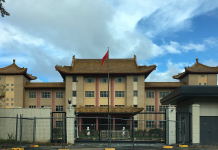URUMQI: Heavenly lakes as blue as the wings of a mythical halcyon bird, the smells of roasting meat penetrating the night air, exuberant embroidery decorating furnishings and hemlines… Welcome to Xinjiang Uygur Autonomous Region.
Speaking of hemlines… China’s ethnic fashions are diverse and comprise everything from hard-to-handle fabrics to fantastical embroidery to fantastical earrings.
Traditionally, the textiles, techniques and accessories are used to preserve some of the histories of China’s 56 ethnic groups, some of which never used a written language to document their stories. Today, they are a source of treasured inspiration. And preservation.
Fashion inspired by local culture references can be a starting point for understanding how a wardrobe, as a dynamic part of contemporary life, can represent and maintain local traditions, including those of the Uygur population.
The Uygurs are Xinjiang’s largest ethnic group. More than 11.6 million Uygur were living in the region, accounting for 44.96 percent of the local population, according to the seventh national census in 2020.
Kashgar, or Kashi in standard Chinese, is an oasis city in the Tarim Basin region of south Xinjiang. It is one of the westernmost cities of China, near the borders with Afghanistan, Kyrgyzstan, Tajikistan and Pakistan. The area has served as a trading post and strategically important city on the ancient Silk Road running between China, the Middle East and Europe for more than millennia, resulting in an eclectic mix of cultures and religions.
–The Daily Mail-Beijing Review news exchange item






